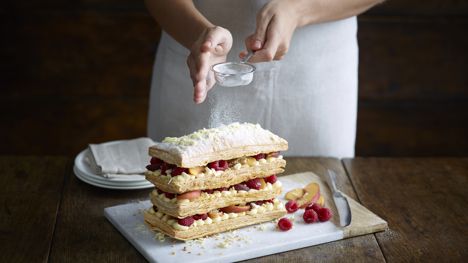Dainty yet showstopping, the phrase ‘mille-feuille’ literally translates as a ‘thousand leaves’ which refers to the layers of delicate pastry that make up the dessert. These are sandwiched together with a creme diplomat filling and fresh fruit, such as raspberries, or jam. Here’s how to construct a mille-feuille worthy of a French patisserie-shop window.
What pastry is mille-feuille made from?
Puff pastry is usually used to make mille-feuille. This is rolled out into a large, thin rectangle which is placed on a baking tray and chilled. In order to get a light but flat piece of pastry this is sometimes pricked and then topped with baking paper and another baking tray in order to weigh the pastry down and stop it from rising too much. Once baked until lightly golden the pastry is cut into several equal rectangles.
What is creme diplomat?
This traditional filling for mille-feuille is a mix of equal parts creme patisserie and heavy whipped cream, often flavoured with vanilla. Try Adam Byatt’s version of creme diplomat which he pairs with strawberries and macadamias in his mille-feuille.
However, if you want to make a easy version of the dessert, a simply flavoured whipped cream can just as easily be used to sandwich the layers together as with our recipe:
Metric
Imperial
- 500g of puff pastry block
- 1 handful of seasonal fruit, for filling
- 300ml of double cream, whipped, for filling
- 1 pinch of icing sugar, for dusting
Preheat the oven to 200°C/gas mark 6. Line two baking trays with baking paper
Dust the work surface and rolling pin with flour. Roll the pastry to a thickness of about 1cm. Turning the pastry by 90˚ as you are rolling will help keep the pastry even
- 500g of puff pastry block
Cut out two rectangles, each one measuring 20cm x 10cm
Transfer the pastry pieces to the lined baking trays and place in the oven for 10 minutes before reducing the temperature to 160°C/gas mark 3 and baking for a further 30–40 minutes
The pastry is cooked when it has risen and is golden-brown all over. Remove it from the oven and leave to cool
Cut the pastry in half horizontally to give you four pieces. Reserve the most attractive piece for the top
Begin to build the mille-feuille by placing one of the pieces on a board and spread it with whipped cream. Arrange your chosen fruits on top before placing a second piece of pastry on top then repeat the process two more times
- 1 handful of seasonal fruit, for filling
- 300ml of double cream, whipped, for filling
Place the reserved piece on top and dust the whole thing liberally with icing sugar
- 1 pinch of icing sugar, for dusting
How do I stop my mille-feuille from going soggy?
Your layered up mille-feuille will only turn soggy if it is left for too long, allowing the pastry to absorb the moisture from the cream and fruit. It is best therefore best to served your mille-feuille immediately, or it can also be chilled in the fridge for up to 2 hours and still retain its crispness.
Can I chill or freeze mille-feuille?
As discussed above, the light pastry in the dessert can go soft if left for longer than a few hours. However you can make the creme diplomat filling ahead of time, covering the bowl with a piece of baking paper so it touches the surface, in order to stop a skin from forming. Then wrap the bowl in clingfilm and chill for up to 3 days. You may need to beat it with a wooden spoon if it has firmed up too much in the chilling process before layering up your mille-feuille on the day.
What flavours can I use in a mille-feuille?
There’s no limit to the fruit combinations and flavours you can use for a mille-fieulle, with classic pairings including strawberries and vanilla cream and raspberry and pistachio, or you can use exotic fruits and flavours such as mango and chilli, or even savoury spins. Take a look at our recipe collection to find your favourite.
Get in touch
Please sign in or register to send a comment to Great British Chefs.

